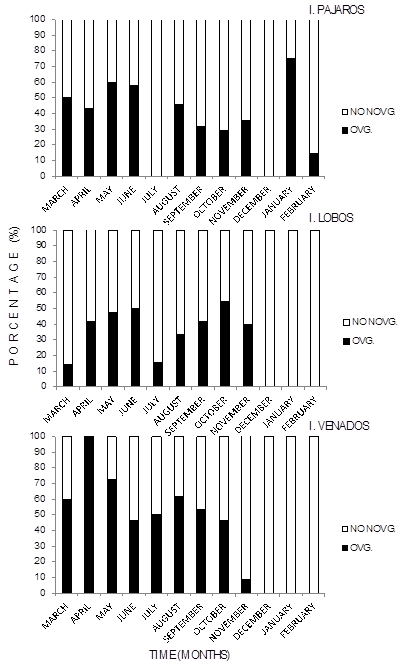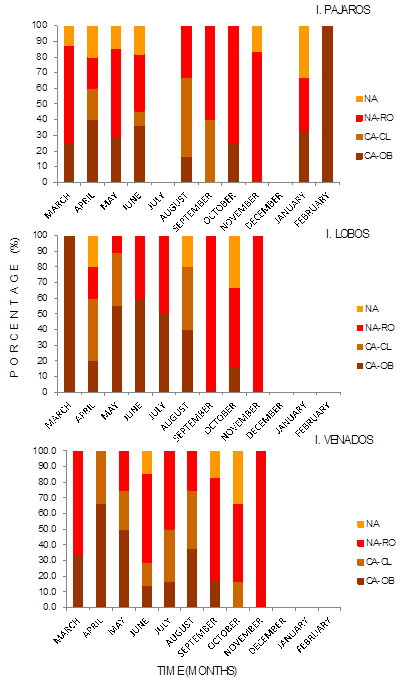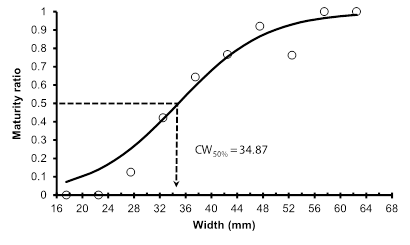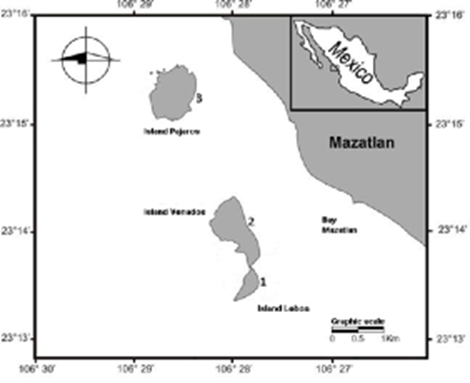INTRODUCTION
Crustaceans are of great nutritional and economic importance to humans. They comprise a resource that contributes a considerable amount of foreign currency to Mexico as exports. Furthermore, many species of crustaceans are considered ecological regulators due to their roles as consumers or contributors to the diets of other species, many of which are of commercial importance 1. Crustaceans are common inhabitants of marine and coastal ecosystems and are abundant on islands as members of very diverse intertidal communities 2,3.
During periods of fishery closures or low availabilities of the resources typically harvested along the Sinaloa coast, coastal fishermen engage in other activities, such as agriculture 4 or the capture of alternative fishery resources. These alternative resources include some species of crustaceans that can be readily caught in shallow waters or in the intertidal zone. One of these species is the rock crab Grapsus grapsus (Linnaeus, 1758), which is used locally as a family food supplement 5 and as bait for fish fishing throughout the year 2.
The rock crab G. grapsus is a poorly studied species despite its wide distribution. It occurs on rocky Atlantic beaches from Florida to Brazil, along the Pacific coastline from California to Chile and on the Galapagos Islands in the Pacific 6,7. In Sinaloa, Mexico, it is found in rocky areas of the coast and islands 2. Some reproductive aspects of the rock crab on the coasts of the Atlantic Ocean have been analyzed 3,8,9.
In northwest Mexico, studies on G. grapsus have been limited to taxonomic and habitat data of crabs collected as reference collections 2. On the islands of the state of Sinaloa, research on the reproductive aspects in G. grapsus is absent. In contrast, various aspects of the biology of other decapod crustaceans in the Mexican Pacific, such as spiny lobster Panulirus gracilis9, Callinectes bellicosus10 and Callinectes arcuatus11 have been analyzed.
This research was carried out to obtain information on the sex ratio, length at maturity, and fecundity of G. grapsus in the intertidal zone on Lobos, Venados and Pajaros islands in the southeastern Gulf of California, Mexico.
MATERIAL AND METHODS
Sampling and collection sites: Monthly crab sampling was carried out between March 2012 and February 2013 at GPS georeferenced sites in the intertidal zone of Lobos, Venados and Pajaros Islands of Mazatlan Bay, Sinaloa, Mexico, within the región 22°13’20´´ - 23º15’17´´ N and 106º27’59´´ - 106º28’41´´ W in the southeast Gulf of California (Figure 1).
Lobos island has a coastline with abundant large rocks 12. Venados Island has a long beach area with a few rocky, clayey headlands; however, at low tide, a large number of rocks are exposed. Pajaros Island has a wide rocky-sandy area 4.
A nightly sampling of crabs was carried out at low tide during spring tides within a 2X25 m quadrant established parallel to the coastline and with the lower limit on the low tide line of each site 3. Thirty G. grapsus organisms per island were collected at random (without selectivity of size or sex), deposited in plastic bags containing sea water and transported to the laboratory in an ice chest. The organisms were measured for total width (CW) with a digital Vernier caliper (0.01 mm) and for total weight (W) with a digital scale (0.1 g sensitivity).
Sexual differentiation, sex ratio, and size at maturity: Brachyuran crabs present sexual dimorphism. Males have a narrow abdomen, whereas adult females have a very wide one that covers most of the sternum. In addition, juveniles and mature females present biramous pleopods, whereas males possess a pair of unirameous pleopods. The sex ratio was estimated, and an X2 test was performed to test the hypothesis of a sex ratio of 1:113. In addition, the percentages of ovigerous and nonovigerous females were calculated. The coloration of the egg sponge of ovigerous females, inactive of the stages of embryonic development, was recorded as follows: a) Orange, b) Red-orange, c) Light brown, and d) Dark brown 3,8,14. Size at maturity (AN50%) was estimated by fitting a logistic model to the data of the proportion of mature females for each length interval 11.
Fecundity: The fecundity of each ovigerous females was determined by the gravimetric method 15. The ovigerous mass (eggs) was removed from each female and dried at 50 °C for 30 min. During this time, the eggs were constantly moved manually to improve the drying of the eggs.
After drying, the eggs were placed on aluminum trays and weighed to determine the dry weight of the egg mass on a digital scale (±0.001 g sensitivity). From each dry egg mass, three 0.5 g samples were randomly collected and placed separately in Petri dishes. The eggs in each sample were counted with a stereoscopic microscope and the average number of eggs of the three samples and the total weight of the dry mass were used to extrapolate the total number of eggs (fecundity) for each ovigerous female 15. A total of 30 eggs were measured (µm). Measurements of eggs were processed and analyzed using Opticam® photomicroscope.
RESULTS
A total of 926 rock crabs were analyzed, of which 407 were females (44%) and 519 were male (56%). The M:F sex ratio was 1:1.13 (X2=15.2, p<0.05). The sizes and weights of the crabs were significantly different among the islands (Kruskal-Wallis, p<0.015) (Table 1).
Table 1 Dunn’s multiple comparison test results for CW (mm) and W (g) of G. grapsus in the intertidal zone of islands in the southeastern Gulf of California. Equal or common letters indicate lack of significant difference between mean values.
| Island | |||
| Lobos | Venados | Pajaros | |
| CW (mm) | 39.91b | 41.47ab | 42.80a |
| W (g) | 28.42 b | 32.29 ab | 33.75 a |
It is evident that the variation between the sexes is related to the reproductive phase of the females. The high incidence of females in the ovigerous stage (71.3%) throughout the study area, indicates that the G. grapsus females in this zone reproduce continuously (Figure 2). In addition, all embryonic phases were observed in this study. Among the ovigerous females, those with orange-red eggs registered the highest percentage, 48.8%, and those with dark brown eggs had the lowest, 26.4% (Figure 3). Eggs diameter varied between 1.1 and 5 µm, with an average of 3.05 µm.

Figure 2 Monthly variation in the propotions of ovigerous and nonovigeraous females of G. grapsus in the intertidal zone of islands in southeastern Gulf of California.

Figure 3 Percentage frequency of sexual stages in G. grapsus females in the intertidal zone of islands in the southeastern Gulf of California (Ca-Ob=dark brown eggs, Ca-Cl=light brown eggs, Na-Ro=orange-red eggs, Na=orange eggs).
The average size at maturity of female crabs was 34.87 mm CW (Figure 4). The average fecundity was 24,339.3 eggs per female, the maximun fecundity was 42,827.5 eggs (Venados Island), and the minimun was 12,682.4 eggs (Venados and Pajaros Islands). The maximun and minimun weight of ovigerous females was 69.9 and 15.2 g, respectively (Table 2).

Figure 4 Size at maturity of G. grapsus females in the intertdal zone of islands in the southeastern Gulf of California.
Table 2 Maximun, minimun, average and standard deviation (SD) of female total weight (PTH), dry weight of the eggs mass (g) (PSMO) and fecundity (FEC) of G. grapsus in the intertidal zone of islands in the southeastern Gulf of California.* no ovigerous females obtained.
| Pajaros Island | Lobos Island | Venados Island | |||||||
|---|---|---|---|---|---|---|---|---|---|
| PTH | PSMO | FEC | PTH | PSMO | FEC | PTH | PSMO | FEC | |
| Mar | 46.5 | 0.314 | 20157.9 | 69.96 | 0.239 | 23658.8 | 46.0 | 0.393 | 27778.1 |
| Apr | 60.0 | 0.356 | 23105.8 | 34.02 | 0.260 | 13142.7 | 54.9 | 0.195 | 12785.7 |
| May | 32.1 | 0.288 | 21347.2 | 38.43 | 0.315 | 20475.6 | 43.7 | 0.704 | 42827.5 |
| Jun | 46.2 | 0.515 | 41631.6 | 51.2 | 0.576 | 36335.4 | 42.8 | 0.331 | 16681.1 |
| Jul | 30.5 | * | 12682.4 | 30.5 | 0.324 | 26909.5 | 27.2 | 0.214 | 12682.4 |
| Agu | 31.5 | 0.223 | 14309.3 | 28.6 | 0.310 | 27654.6 | 32.3 | 0.295 | 20188.6 |
| Sep | 32.4 | 0.192 | 15936.1 | 26.7 | 0.278 | 28399.7 | 37.4 | 0.376 | 27694.7 |
| Oct | 25.0 | 0.251 | 21196.1 | 38.0 | 0.249 | 21542.5 | 20.0 | 0.209 | 24381.1 |
| Nov | 36.0 | 0.393 | 38576.7 | 30.1 | 0.340 | 26119.6 | 15.2 | 0.249 | 25808.6 |
| Dic | 43.8 | 0.401 | 37008.9 | * | * | * | * | * | * |
| Jan | 51.5 | 0.410 | 35441.2 | * | * | * | * | * | * |
| Feb | 45.3 | 0.276 | 14733.4 | * | * | * | * | * | * |
| Max. | 60.0 | 0.515 | 38576.7 | 69.9 | 0.576 | 36335.4 | 54.9 | 0.704 | 42827.5 |
| Min. | 25.0 | 0.223 | 12682.4 | 26.7 | 0.239 | 13142.7 | 15.2 | 0.195 | 12682.4 |
| Average | 40.1 | 0.329 | 24677.2 | 38.6 | 0.321 | 24915.4 | 35.5 | 0.329 | 23425.3 |
| SD ± | 10.4 | 0.095 | 10537.1 | 13.9 | 0.101 | 6390.9 | 13.0 | 0.158 | 9386.1 |
DISCUSSION
The percentages of sexes of G. grapsus did not present a pattern that allows defining a segregation between females and males, as has been described in other decapod crustaceans of commercial interest in some of the main bays of Sinaloa, such as Callinectes bellicossus10, Panulirus inflatus and Panulirus gracilis14.
Although monthly variation in the sex ratio was observed, sex showed dominance over the other, possibly indicating that the two sexes do not compete for spaces, settlement or refuge 2. The population inhabits rocky substrates, which are common on these islands 12.
The sex ratio of the G. grapsus population is an indicator of stability; although the males dominated slightly in the samples on the islands, there was no significant bias in the sex ratio. This finding is consistent with the findings regarding the percentage of ovigerous females in the population, which indicates that G. grapsus actively reproduces in this area. However, the percentages of ovigerous and nonovigerous females differed among the three islands. Regarding potential G. grapsus fishery regulations, Pajaros Island could be considered as a refuge. On this island, the reproduction and the presence of ovigerous females of the rock crab are continuous throughout the year. In contrast, on Lobos and Venados Islands, ovigerous females were absent between December and February. The rock crab population on these islands should continue to be analyzed to determine the months with the highest proportions of ovigerous females and thus the main reproductive period of G. grapsus females. This information could be used to guide the selection of closure periods for the protection of this resource.
On all three islands, the embryonic phase that predominated was the orange-red phase. It is possible that this phase spans a longer period of time than the other phases. Among the phases, this phase accounted for the highest number of eggs (fecundity) of G. grapsus ovigerous females.
The embryonic phase representing the second highest percentage was the dark brown, corresponding to eggs in the last stage of maturation. The dark color of the eggs in this phase is related to the development of the eyes of the nauplius larvae 16 and the eggs in this phase are possibly approaching hatching. This phase of embryonic development was the only phase that was observed in February and March on Pajaros and Lobos Islands, respectively. The rest of the year females with dark brown eggs (close to spawn) and females with eggs of the first embryonic phase were found simultaneously. The period of embryonic development in this area may comprise a short period of time, as it does in other brachyuran crabs, such as Callinectes sapidus, in which embryonic development spans 12 days 17.
The size at maturity estimated for G. grapsus in this area (34.8 mm) is very similar to that estimated for this species in Ecuador CW50% = 33.8 mm) 18. A congener, Grapsus adscensionis, reaches morphological maturity at a cephalothorax width of 43 mm 19. In all three species, the height at maturity has been reported to reach slightly above 50% of the maximun size in females (between 55 and 58%), as has been reported for other grapsid crabs 19. In this study, the size at maturity refers to the size at morphological maturity; however, it has been reported that physiological maturity occurs at the same time as morphological maturity in species of this genus 18,19.
This study is the first to determine the size at maturity of the rock crab in the southeastern Gulf of California. It can serve as a base study for future population research on this species and for the formulation of fisheries management proposals for G. grapsus in this area. Another species of crabs, was estimated the size of first maturity such as in Checeon notialis17. Becerra Ribeiro et al.18 determined a minimun size of first maturity in CW in Sesarma rectum of 22.97 mm, both studies carried out in northwestern Brazil. In C. sapidus, Severino-Rodrigues et al. 19 estimated a minimun size of first maturity in 103.3 mm (CW), in addition these authors pointed out that the reproductive activity of this specie occurs at larger size.
It is important to continue analyzing the first maturity sizes of G. grapsus in this area since their variation could be related to the reproductive strategies of the population. Pointing out the first maturity size in the catches can prevent preventing the stock from being over exploited.











 texto em
texto em 




